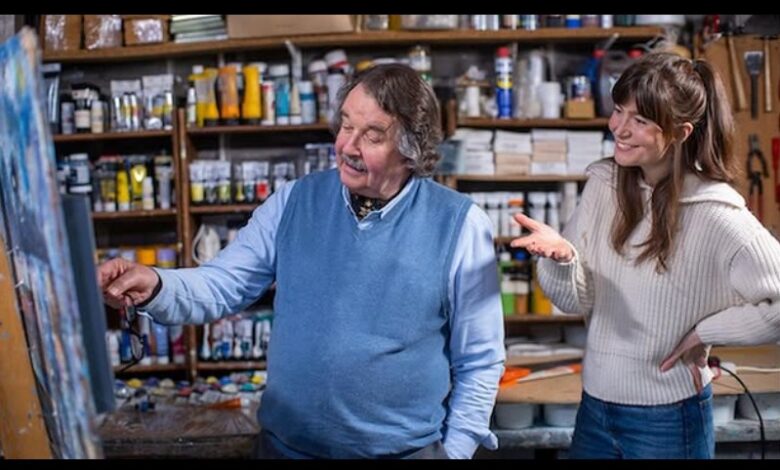Philip Raskin: The Scottish Artist Who Paints Silence and Light

The Life and Inspiration of Philip Raskin
Philip Raskin is one of Scotland’s most admired contemporary artists, best known for his breathtaking seascapes and landscapes that capture the changing moods of the Scottish coast. Born in Glasgow in 1947, he grew up surrounded by the visual drama of Scotland’s skies, hills, and waters—an environment that would one day shape his entire artistic philosophy. From a young age, Raskin showed an aptitude for drawing and painting, leading him to study at the prestigious Glasgow School of Art during the 1960s.
However, his journey into art was not a straight path. The sudden death of his father forced him to leave his studies early, placing his artistic ambitions on hold. What makes Philip Raskin’s story remarkable is that his eventual success as a painter came after a long detour through a completely different world—the world of business.
From Restaurateur to Respected Painter
Before returning to painting full-time, Philip Raskin spent around two decades in hospitality. Alongside his wife, Barbara, he ran a successful restaurant and jazz venue in Glasgow called The Inn on the Green. This establishment quickly became one of the city’s favourite cultural spots, blending fine dining with live music and creative exhibitions. Even during this time, Raskin remained close to the arts. The restaurant often doubled as an informal gallery, with artwork displayed around the walls, hinting at his enduring love for visual storytelling.
By the early 1990s, Raskin made the courageous decision to leave the restaurant industry and dedicate himself fully to his passion. He set up a studio in Strathaven, South Lanarkshire, and began producing paintings that would soon become recognisable across galleries in the United Kingdom and beyond.
The Artistic Style of Philip Raskin
The Essence of Light and Texture
Philip Raskin’s paintings are celebrated for their atmospheric beauty and technical mastery. He often paints Scottish coastlines, islands, and seascapes that convey tranquillity, reflection, and solitude. His distinctive use of light is central to his work. Each canvas seems to shimmer with shifting skies and glowing horizons, reflecting the unpredictable moods of Scottish weather.
Raskin’s technique relies heavily on the impasto style—thick, expressive brushstrokes that add texture and depth to his compositions. The result is a tactile surface that captures not just what the eye can see, but what the viewer can feel. The artist himself has said that he paints “private places for the viewer to own and enjoy—no people, no houses, just mist, tide, and silence.” This philosophy defines his approach: simplicity, purity, and emotional stillness.
Colour and Composition
Unlike many landscape painters who rely on bright colours, Raskin favours a restrained palette. He works with soft, muted tones—greys, blues, creams, and silvers—to evoke the soft diffused light of Scotland’s skies and seas. His compositions are balanced and contemplative, often featuring a subtle horizon dividing sea and sky, with clouds that appear to move gently across the frame.
Each painting invites the viewer to pause. There is no noise, no chaos—just the harmony of nature rendered through masterful control of light and shadow.
Career and Recognition
Exhibitions and Gallery Presence
Philip Raskin’s rise as a professional artist was steady but consistent. After re-entering the art world, he began exhibiting across Scotland in respected galleries such as the Strathearn Gallery in Crieff, the Annan Gallery in Glasgow, and others across the United Kingdom. His work has since travelled internationally, finding homes in private collections across Europe, North America, and Asia.
Collectors are drawn to his paintings for their serenity and emotional resonance. Many describe owning a Raskin painting as having a “window into peace”—a visual retreat from the chaos of everyday life.
Commercial Success and Legacy
Raskin’s artworks frequently appear in auctions and art fairs, where they command strong interest and competitive prices. His success in both gallery and auction settings confirms his dual appeal to art lovers and serious collectors alike. Unlike many contemporary artists, Raskin has maintained a consistent style and thematic focus throughout his career, which has become his trademark.
Personal Life of Philip Raskin
Beyond his painting, Philip Raskin is known for his family’s connection to the arts. He is the father of Natasha Raskin Sharp, the Scottish television presenter and antiques expert recognised for her appearances on popular BBC programmes such as Antiques Road Trip and Bargain Hunt. Natasha has often spoken about her father’s influence, describing how she grew up surrounded by art and creative energy.
Raskin’s wife, Barbara Raskin, has been an integral part of his journey, both during their years in business and in his later artistic career. Their partnership reflects the balance and harmony seen in his paintings—a shared appreciation for creativity, culture, and the Scottish landscape.
The Philosophy Behind Philip Raskin’s Art
Philip Raskin’s paintings are more than visual representations of places; they are emotional meditations on peace, time, and nature. He strips away distractions—people, buildings, artificial light—and focuses instead on raw, unspoiled beauty. His paintings remind viewers of how small yet connected humans are within the vastness of nature.
For Raskin, painting is a conversation with silence. He captures fleeting moments—the glow before dusk, the silver calm after a storm, or the faint mist hovering over a tidepool. These are not grand, heroic scenes; they are intimate, contemplative spaces where imagination and reality merge.
Why Philip Raskin’s Work Endures
Philip Raskin’s art endures because it speaks to universal emotions. Whether seen in a gallery or a private home, his paintings evoke calm, nostalgia, and reflection. Viewers often find themselves drawn to the horizon lines he paints—a metaphor for possibility, memory, and distance.
His disciplined technique, honed over decades, combines classical sensibility with contemporary simplicity. Each stroke feels intentional, each shade of light measured with precision. Raskin paints the kind of beauty that does not shout; it whispers.
Conclusion: The Lasting Brilliance of Philip Raskin
Philip Raskin stands as one of Scotland’s most distinctive living painters. His journey from art student to restaurateur and finally to full-time artist exemplifies resilience, passion, and self-belief. Over the decades, his name has become synonymous with quiet power and the poetic beauty of Scottish nature.
Today, at over seventy years of age, Raskin continues to paint from his studio in Strathaven, creating works that illuminate the essence of stillness. Through every brushstroke, he preserves a timeless vision of Scotland—where light dances across water, skies whisper stories, and silence feels alive.
In a world that moves too fast, Philip Raskin’s art offers what we most need: a moment to breathe, to look, and to remember the simple grace of the natural world.
FAQs
Who is Philip Raskin?
Philip Raskin is a renowned Scottish contemporary artist best known for his evocative seascapes and landscapes that capture the light, mood, and beauty of Scotland’s coastlines.
Where was Philip Raskin born?
He was born in Glasgow, Scotland, in 1947.
How old is Philip Raskin?
As of 2025, Philip Raskin is 78 years old.
Where does Philip Raskin work?
He works from his studio in Strathaven, South Lanarkshire, Scotland.
What is Philip Raskin famous for?
He is famous for painting Scottish seascapes and landscapes using thick impasto brushwork and subtle light effects that evoke serenity and atmosphere.
What style of art does Philip Raskin paint in?
His work combines realism and impressionism with textured brushstrokes, focusing on natural light, mist, and water reflections.
Who is Philip Raskin’s daughter?
His daughter is Natasha Raskin Sharp, a well-known BBC television presenter and antiques expert.
Who is Philip Raskin’s wife?
His wife is Barbara Raskin, who supported him throughout his career and co-managed their Glasgow restaurant before he became a full-time artist.
Where did Philip Raskin study?
He studied at the Glasgow School of Art during the 1960s.
What makes Philip Raskin’s paintings unique?
His art is recognised for its peaceful solitude, refined palette, and mastery of Scottish light — creating paintings that feel both intimate and timeless.



